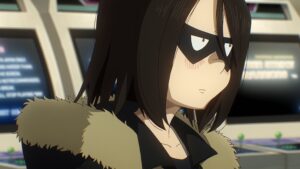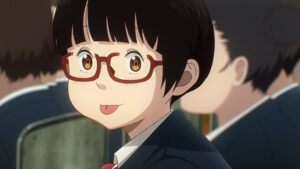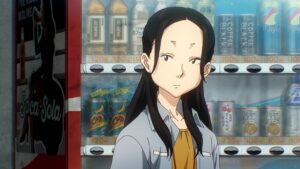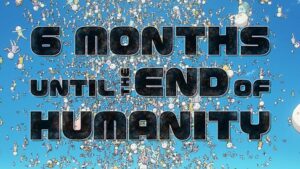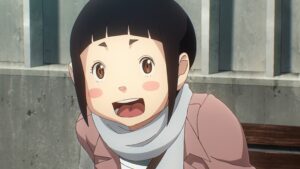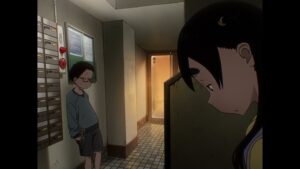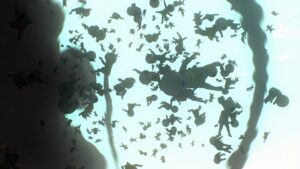The countdown to August 32nd has begun, but Dead Dead Demon remains fiercely committed to its coming of age story.
I don’t know if I’ll ever return to weekly blogging, but these five episodes certainly made a case for the practice. When you write about an anime every week, there’s a lot less to juggle, mentally speaking, than there is when you have to synthesize two hours’ worth of material into a single post. Some shows (like this one) make it even trickier to keep things straight by including lengthy flashbacks, or even hinting at the existence of alternate timelines. I’ve got a Word doc full of notes and a folder full of screencaps to help keep things straight, though, so let’s see how I do.
What is August 32nd? Technically, the show doesn’t use those words, but it does reference a future event called 8/32 – a sort of spiritual successor to 8/31, when the alien mothership first appeared over Tokyo a little over three years ago. Kadode alerts us to this pivotal future “date” in a monologue at the end of episode 8, but despite the major implications of its non-Gregorian numbering, most of her speech focuses on the mundane: the time she’ll spend with her friends in the leadup to 8/32, rather than the chaos that will swallow Tokyo when that day arrives. This is something I really admire about Dead Dead Demon – it can run sci-fi and slice of life plots in parallel and not skimp on either one.
As far as the slice of life plot goes, the major development in this group of five episodes happened toward the end: the girls graduated from high school and began attending Surume University together. The series’ mood during the graduation scenes was optimistic, with a mild twist provided by Inio Asano’s trademark off-color humor; as Kadode talked to her now-former teacher and current crush after the ceremony, Ontan held up a notebook to reveal a double page spread that read, “SHOW HIM YOUR BOOBS.” And when the girls discussed their future plans and Kadode expressed a desire to enter the publishing industry, Ontan declared it to be a great idea: “You’ll infiltrate the media and spread antisocial thoughts among the masses!” (Whether or not you think it’s accurate, this is surely a reference to the way people perceive Asano’s work.)
Before the girls could attend their first day of college classes, the show introduced two new characters from Ishikawa Prefecture (which is on the smaller side), both in search of the sort of open-minded environment that Tokyo might provide. There’s the rabbit-nosed Futaba, whose firm belief in the existence of alien invaders prompts her to enroll at Surume University, and the buck-toothed Makoto, who hopes that their preferred gender expression will be more accepted in a metropolitan city. (I’m using neutral language for Makoto because, although they wear traditionally feminine clothing and their dream is to be an idol, they don’t seem to identify as a girl; it’s far more important to them to be viewed as “pretty.” It might be more accurate to call them an otokonoko, but I only learned that term a couple months ago, so it may not apply here.)
The way that Futaba and Makoto are integrated into the show’s civilian plot is another of the series’ recent triumphs, as their arrival in Tokyo coincides with both a major sci-fi event (more on that later) and our central characters’ first week of university. Friendships between the Kadode/Futaba and Ontan/Makoto pairings build swiftly, though this smoothness is balanced by Futaba’s difficulty in relating to Ontan. (Ironically, Futaba ought to be drawn most closely to Ontan, a suspected “Shifter,” given her interest in and compassion toward the aliens hovering over Tokyo.) Honestly, all the character-oriented stuff in this batch of episodes works quite well… with one exception, at least in my opinion.
That exception would be the second half of the two part flashback to Kadode and Ontan’s primary school days. After the show transitioned in and out of those memories in episode 4, I thought we’d have to wait a while before getting another glimpse of the past, but the next two episodes dove right back into Ontan’s head. Beginning with the girls’ second meeting on a cram school trip, episode 5 used their encounter and subsequent acquaintanceship with an alien to flesh out their childhood personalities, which were a hell of a lot different than the ones they’re sporting in the present day. Ontan was more shy than quirky in elementary school – almost cripplingly so – while Kadode (nicknamed “Demon” by her cliquey classmates) was the more active of the two. When Kadode got her hands on some of the alien’s gadgets, she quickly enacted a plan to use them for the greater good, and thus prove to their extraterrestrial guest that Earth didn’t need to be invaded.
So what’s my issue with this story? That would be Kadode’s sudden spiral into a similar headspace as Light from Death Note, which was entirely contained within episode 6. Equipped with physics-defying tools from another world, she began to view herself as humanity’s judge, at first using message boards to identify her victims and working her way up to murdering Ogino, a Cabinet member whose corruption allegations she watched on the news one night. (Crucially, Ogino is Prime Minister in the present day, proving that these memories either originate from another timeline or else are entirely fabricated.) Eventually, this quiet version of Ontan confronted her friend with the heinousness of her crimes, leading Kadode to withdraw from school; when Ontan visited her new apartment, Kadode delivered an indirect goodbye to her only friend before jumping to her death.
This second phase of the flashback moved too quickly for me to keep up emotionally, as the Kadode I got to know in the first four episodes, while certainly not a jubilant teenager, was neither so vindictive that she’d take anyone else’s life nor so tortured that she’d take her own. Even if you assume that her relationship with her parents was just as strained in this alternate timeline as it is in the present day, and even if you factor in her classmates’ bullying, her journey from sullen sixth grader to violent vigilante should have been a slower one. The moments just before Kadode’s suicide were still effective thanks to the reddened color scheme and the building string accompaniment, and there was a strong parallel between her resigned smile as she entered freefall and her joy at flying with the alien’s headgear just one episode prior. But even that connection serves to highlight the abruptness of her demise, relative to the better times surrounding it.
The two episodes we’ve just discussed represent the closest fusion of Dead Dead Demon’s two identities, since the aforementioned alien’s repeated meetings with Kadode and Ontan are a major checkpoint, even if much of the focus is on the human characters. Once the show reenters the present day, it returns to running its stories in parallel, though there are still some potent instances of overlap. The conclusion of episode 7, for example, gives us a preview of the girls’ high school graduation, while intercutting it with an anti-alien military operation, resulting in the death of an invader whose companion mourns them in a remarkably human way. There’s also the end of episode 8, where one of Japan’s Chokujin defense systems vaporizes an alien spacecraft, revealing the hundreds of toddler-sized, helmet-wearing beings inside; Futaba and Makoto, the aforementioned Ishikawans, watch in horror through the window of their Tokyo-bound plane as the aliens fall to Earth. (Come to think of it, director Kurokawa has a penchant for saving each episode’s biggest moment until the last few minutes.)
But there are also moments where the series’ sci-fi side takes over completely, and though I think it’s the slice of life stuff that makes this show stand out in its field, I have to admit that secret discussions of a “flying ark” are the most intriguing element of the show after nine episodes. Based on a conversation between the head of SES Corp and Prime Minister Ogino, as well as hints from the journalist and the PR woman from the first few episodes, we could infer that Tokyo is headed for catastrophe even without Kadode’s 8/32 monologue. Currently, it seems like a privileged class of people will board this “ark” in advance of that catastrophe, leaving the common man to fend for themselves when tensions between Japan and the invaders come to a head. If Dead Dead Demon can navigate that event without losing sight of its character relationships in the process, I’ll be a happy viewer.

